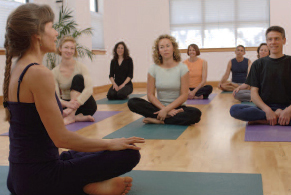Cover Story: The Benefits of Physical and Social Activity
The importance of filling your life with the activities and people you value
Written by Samantha Artherholt, PhD; Aimee Verrall, MPH; and the Rehabilitation Research and Training Centers for Multiple
Sclerosis and Aging with Disabilities – University of Washington, Seattle, WA
Edited by Susan Wells Courtney
Reviewed by Jack Burks, MD; Kathleen Costello, MS, ANP-BC, MSCN; Adam Kaplin, MD, PhD; Kathy Zackowski, PhD, OTR, MSCS; and Cindy Richman,
MSAA Senior Director of Services
See Also:
Physical Activities for Individuals with MS
Social Activities for Meeting New People
Remaining active and engaged in life can be challenging with any chronic condition, including multiple sclerosis (MS). Despite the challenges, living a rewarding life – one that is filled with the activities and people you value – doesn’t need to be out of reach. In this article, we’ll discuss the benefits of physical and social activity for people living with MS, and provide some strategies for engaging (or re-engaging) in those areas.
PART I: PHYSICAL ACTIVITY
People with MS may face major challenges when trying to resume physical activities that they enjoyed before their symptoms began. According to the article, “Physical activity and its measurement and determinants in multiple sclerosis” [RW Rotl, Minerva Med. 2008 Apr;99(2):157-65], “Overall, there is fairly strong and consistent evidence that individuals with MS are largely inactive compared with non-diseased populations… and the emerging research has highlighted the role of symptoms in explaining inactivity in this population.”
Although remaining active may be more difficult when experiencing symptoms, increasing one’s physical activity has the potential for significant health benefits among individuals with MS. Currently, no clear recommendations are available on the amount of physical activity that is appropriate for people with MS. Guidelines for adults without a chronic condition are 150 minutes of moderate-intensity aerobic activity (such as walking) per week, plus muscle-strengthening activities at least twice per week. The best advice is to talk to your doctor or physical therapist about the amount and type of regular physical activity that is right for you.
You may find many benefits to remaining physically active, both for your body and for your mind. Studies of individuals with MS indicate that exercise results in improved strength, reduced pain, less stress, improved mood, and greater endurance. Regular exercise can also help prevent other diseases that can impact your life and your health.We know that exercise provides many benefits to your heart and vascular system. It can increase the efficiency of the heart, and decrease the risk of heart disease. Regular physical activity can lower blood pressure and decrease harmful (LDL) cholesterol, while increasing good (HDL) cholesterol. Exercise can also help regulate blood sugar levels and prevent diabetes. In addition, physical activity can help to maintain muscle strength, maintain bone density and reduce the risk of fracture, and regulate breathing.
Another important benefit of exercise for individuals with MS is that it can help you to maintain your current level of physical function, or perhaps even regain some of the function and strength you may have lost. For example, you might be able to strengthen your leg muscles, or improve your level of cardiovascular fitness, enabling you to remain independent and perform activities of daily living that are important to you. These may include basic, everyday activities such as bathing and dressing, taking care of things around the house, and running errands.
Remaining physically active can also improve some of the symptoms of MS. We know from research that people with MS who exercise can decrease pain and increase blood flow to the lower extremities. Exercise can also decrease hospitalizations resulting from some of the effects of MS. Exercise has been shown to improve energy levels and reduce general fatigue – an important issue for many individuals living with MS. Regular exercise may also help you to maintain your mental sharpness.

We also know that exercise can have a powerful impact on mood. People who are more active are less likely to experience low mood or depression. By the same token, research has shown that increasing your level of physical activity can be an effective way to improve mood. Inactivity might even contribute to the higher rates of depression we see in individuals with MS. One study found that aerobic exercise was an effective treatment for major depression and was as effective as sertraline (the generic version of Zoloft®, an antidepressant) for treating major depression in older adults. Interestingly, people treated with exercise were significantly less likely to relapse back into a depressive episode as compared to those who only took the sertraline.
Even if you’re not struggling with depression, exercise can still have a positive impact on mood and on the overall quality of your life. Physical activity is one of the most effective tools that we know of to relieve stress. Exercise can also help you to feel more in control of your MS symptoms. It can increase your self-confidence and contribute to a healthier body image. And, depending on what kind of activities you do, exercise can provide great opportunities for social interactions. For example, you could walk regularly with a friend or neighbor, or perhaps find an exercise class designed specifically for people with MS. In many communities, there are MS aquatics programs and adapted yoga programs that are often appropriate for individuals with mobility issues.
Kathy Zackowski, PhD, OTR, MSCS is an occupational therapist and assistant professor in the Department of Physical Medicine and Rehabilitation, Kennedy Krieger Institute, at Johns Hopkins University School of Medicine in Baltimore, Maryland. Dr. Zackowski explains, “Individuals with MS can also take regular exercise classes and look for beginner classes. If you feel uncomfortable doing this, talk with the instructor so he or she knows to help you modify exercises or stretches that may be too difficult.”
Any exercise program needs to be appropriate for your capabilities and limitations, and may need to be adjusted as changes occur in your MS symptoms. A physical therapist experienced with the unique and varied symptoms of MS can be helpful in designing a well-balanced exercise program, along with adjusting it in the future as needed. If you are thinking of starting a new exercise program, you should also consult with your physician to be sure the exercises will be safe for you.
Dr. Zackowski adds, “An occupational therapist can help you to make choices about how to fit in time for exercise and where in your home you can best do your exercises. He or she can also provide tips on how to conserve your energy with your daily tasks, so you have energy left for exercise.”
TYPES OF PHYSICAL ACTIVITY
Three main categories of physical activity will be reviewed in this article:
- Stretching and flexibility
- Aerobic activity
- Strength training
In general, a warm-up is recommended before engaging in any of these three types of activity. A warm-up just means getting your body moving for five to ten minutes. For example, you can do some light walking or wheeling, swing or punch your arms, roll your shoulders, or lightly tap your toes from side to side. Any slow and controlled movements that start to get your heart rate up will work as a warm-up.
Stretching and flexibility exercises can be done gently at the start of a workout (after you warm up), more deeply at the end of an aerobic or strength-training workout, or alone. Yoga is one example of an extended stretching or flexibility type of workout. The gentle movements of tai chi may also be a good way to stretch. Although studies about the benefits of stretching are mixed, stretching can help you to improve your flexibility, provided your doctor approves. Better flexibility may improve your performance in physical activities (making basic activities of daily living easier) and decrease your risk of injuries by helping your joints to move through their full range of motion. Stretching also increases blood flow to your muscles.
Here are some tips to consider when stretching:
Don’t use stretching as a warm-up exercise. You may hurt yourself if you stretch cold muscles. Either warm up before you stretch, or stretch after you exercise when your muscles are already warm.
Focus on major muscle groups. When you’re stretching, focus on your calves, thighs, hips, lower back, neck, and shoulders. You may wish to focus on muscles and joints that are especially stiff from your work or play. Make sure that you stretch both sides of your body; if you stretch your left hamstring, be sure to stretch your right hamstring, too.
Don’t bounce. Bouncing as you stretch can cause small tears in the muscle, making you less flexible and more prone to pain. Hold each stretch for about 30 seconds, remembering to relax and breathe as you wait for the 30 seconds to go by. Repeat each stretch three or four times.
If a movement hurts, you’ve pushed too far. Expect to feel tension while you’re stretching, but not pain. If you feel pain, back off a bit until the pain goes away.
Keep up with your stretching. You can achieve the best benefits by stretching at least two to three times per week.

Aerobic exercise is any activity that increases your heart rate. This can include activities such as moderate to fast walking or wheeling, running, dancing, swimming, water aerobics, bicycling or arm cycling – the possibilities are almost endless! When you are doing aerobic exercise, monitoring your heart rate and level of exertion is very important. The three levels of intensity, or “hardness,” of exercise are light, moderate, and vigorous. In general, aiming for at least moderate-intensity exercise offers the best health benefits (again, with your doctor’s approval). With moderate-level activity, you will feel as though you are working somewhat hard, but you will also feel that you can keep going for awhile. Your heart may be beating harder and faster than normal, but not extremely fast. Also, your skin may be warmer than normal and could be sweaty as well.
Strength training is simply moving weights or using resistance, with the goal of building muscle and bone strength. The three basic factors in strength training are repetitions (“reps,” or the number of times you perform the move), sets (a certain number of repetitions performed in a row), and weight (the amount you are lifting, usually stated in pounds).
Here are some tips for any strength-training regimen:
Start with lighter weights until you are comfortable with the moves and your body positioning. Whether you’re sitting or standing, don’t strain other parts of your body to complete the move.
Find a weight that you can lift between 10-15 times without getting too tired.
If you can perform more than 15 reps easily, the weight is probably too light for you. If you have trouble getting to 10 reps before tiring, try a lighter weight.
In general, two to three sets of any given strength-training exercise is suggested, with a short rest in between.
Don’t work the same muscle groups every day. You can either alternate muscle groups (upper body one day, lower body the next) or take rest days in between strength-training workouts to give your muscles time to recover.
 Elastic exercise bands, available from physical therapists or at sporting goods stores, are a nice alternative to hand weights. They are inexpensive and easy to store, and come in several different resistance levels (different colors correspond to the degrees of difficulty).
Elastic exercise bands, available from physical therapists or at sporting goods stores, are a nice alternative to hand weights. They are inexpensive and easy to store, and come in several different resistance levels (different colors correspond to the degrees of difficulty).
SAFETY
Safety is a priority for any exercise program. Individuals with MS may need to pay particular attention to body-heat issues. If you are particularly sensitive to heat, you may consider using cooling methods while you exercise, such as a damp cloth, fan, spray bottle, or cooling vest. Heat-sensitive individuals should exercise during the cooler times of the day. People with MS also need to pay close attention to fatigue. If physical activity is making your fatigue worse overall, you may need to slow things down a bit. You will be more likely to stick to an exercise program if you implement it gradually, over a longer time period.
TAKING ACTION
So, how do you get started on an exercise program? You can find many ways to do this, but research shows that some strategies are better than others:
Start gradually. Make a plan for increasing your activity slowly.
Find activities you enjoy and can do easily. Do you love to hike? Maybe swimming is your thing? If so, see if you can participate in these activities. Or, you can try something new! Take a class in something that is of interest and new to you such as Zumba, belly dancing, tai chi, or yoga. For many, just doing more of what you are already doing, such as walking, is a great place to start. You can increase the time and intensity gradually, maybe by 5 percent, and go from there.
Find a way to work exercise into your daily or weekly routine, so you won’t have to think about it as much. Consider the time of day that you are the most energetic, and plan to exercise at that time.

Goal setting is important, and you can write down or tell someone what you intend to do. The most effective goals are not simply to say, “I’m going to exercise.” Be specific – ideal goals will include what you will do, when, where, how long, and so forth.
Self-monitoring is also important, and this can be as simple or as detailed as you would like. Check off the days you meet your goals, such as exercising at least 10 minutes or walking a certain distance. You may want to keep a log of your exercises, weight used, repetitions, and so forth.
Feedback can be very helpful to your progress. Look at the self-monitoring data you are keeping. How far are you walking now versus two weeks ago? How many repetitions now versus when you started? Notice your progress. When you can’t meet your goal, identify the barriers and see if you can find ways to safely overcome them. Keep in mind that with MS, you may have certain limitations that you didn’t have before, and you need to avoid any type of overexertion – so goals that are too difficult will need to be adjusted to best fit your abilities.
Positive consequences can provide motivation for you to continue to work toward your long-term exercise goals. As you reach new accomplishments, reward yourself! Don’t be stingy. If you are moving in a positive direction, even though you might have only completed 50 percent of what you hoped, this merits recognition. Plan the reward ahead of time. Think of healthy ways to treat yourself that are easy to do and fit your budget. Ideas might include: renting a new movie to watch with family or friends, treating yourself to a healthy dessert (such as a fruit smoothie), buying something new to wear while working out, putting fresh-cut flowers in a vase to enjoy and remind you of your success, or simply allowing yourself some extra time to rest and appreciate what you have accomplished.
RESEARCH ON THE BENEFITS OF EXERCISE
According to the article, “Effect of Exercise Training on Depressive Symptoms Among Patients With a Chronic Illness” [MP Herring, et al., Arch Intern Med. 2012; 172(2):101- 111], lack of exercise and depression are commonly observed in individuals with chronic illness. In this meta-analysis, 90 articles involving studies of more than 10,500 inactive patients were systematically reviewed. Researchers concluded that for individuals with a chronic illness, exercise reduces the symptoms of depression. They also found that individuals who have mild-to-moderate depression and experience improved function from exercise, have the largest reduction in their depressive symptoms.
Another large review of research literature was conducted to determine the relationship between physical activity and cognitive function. Results were reported in the article, “Physical activity for the prevention of cognitive decline” [MD Denkinger, et al., Z Gerontol Geriat. 2012; 45:11-16]. Among the “practical conclusions” of this study, researchers found that “Physical activity is beneficial for older adults in primary, secondary, and tertiary prevention of dementia and it is never too late to start.” Researchers also found that moderate-intensity exercise, including brisk walking, for at least 30 minutes per day and five days per week, provided the best results.
Reminders are a quick and easy way to keep exercise on your mind – and we can all use these types of cues and prompts. Whether is it a low-tech sticky note on the bathroom mirror, a digital reminder on your smart phone, or a friend who calls you at the time you are due to be out the door – any reminder that works for you can help you to get going and stay on track. Another idea is to consider exercising at the same time each day (you can still vary your activities so some days you only stretch and other days you are doing cardio or strengthening). By planning to exercise at the same time each day, this becomes easier to remember.
Exercise with a friend. Having someone to work out with is a great help to sticking with an exercise program. Walk with a neighbor, find a workout partner, or join a class at your local gym or YMCA/YWCA. This gives you the benefit of both physical and social activity at the same time! (The benefits of social activity appear in Part II of this article.)
RESOURCES TO HELP YOU
If you need help getting started on an exercise program, many resources are available to help you! First, talk to your doctor to make sure exercise will be safe for you. A physical therapist who has experience in working with people with MS may have some great ideas. A local occupational therapist may know of community resources. Look into online resources such as the National Council for Physical Activity and Disability (at www.ncpad.org) and MS-specific agencies and support groups. Your local YMCA/YWCA or community center may also have good and inexpensive options for increasing your physical (and social!) activity. MSAA has recently launched its new database, My MS Resource Locator (at resources.mymsaa.org), which provides many contacts for a variety of services.
WHEN EXERCISE BECOMES A CHALLENGE
Kathleen Costello, MS, ANP-BC, MSCN, is a research associate/nurse practitioner at The Johns Hopkins MS Center (part of Johns Hopkins University) in Baltimore, Maryland. She notes, “Many times patients have fatigue levels or mobility issues that cause them to feel that they cannot exercise at all. It is tough to think that exercise can be incorporated in a day when one has barely enough energy to do what is absolutely necessary. In these situations, an evaluation with rehabilitation specialists can be most helpful to design an exercise program with goals that are realistic and attainable. Even when mobility is significantly compromised, exercise is still possible – and can still be quite beneficial.”
MSAA Senior Director of Services Cindy Richman explains, “When patients experience more weakness or loss of strength, they really need to be evaluated by a physical therapist. The longer someone waits, the more difficult exercise and other activities may become for that individual. Sometimes spasticity is an issue that gets in the way, yet in most instances, spasticity can be managed. Often patients just wait too long or don’t realize their options – and this can be avoided. No one should miss out on the many valuable benefits of exercise and physical activity simply because he or she wasn’t aware of the opportunities available.
“I also want to emphasize that people who have more burden of disease may continue to exercise as well, provided they have their doctor’s approval. Physical and occupational therapists are able to recommend exercises designed specifically for individuals who need to perform activities from a sitting or even a reclining position. Finding a physical or occupational therapist with experience in MS is important, and consulting your neurologist or MS center for a recommendation is a good way to find the right professional. If this is not possible, individuals should ask questions to evaluate the therapist and ensure that he or she has enough experience with MS.”
Readers are also reminded that MSAA’s Multiple Sclerosis Information (MSi) online video and webinar library has two on-demand videos available to view on the topic of exercise. Both may be accessed by going to the MSi section.
MSAA’s Lending Library also has references available on the topic of exercise and MS. You may view a listing of MSAA’s book and DVD collection available for free loan by going to MSAA’s “Lending Library”
PART II: SOCIAL SUPPORT
 Our social relationships have a powerful influence on our health and well-being. Social relationships are what tie us to the other people around us: our significant other, friends, family, co-workers, neighbors, and community or religious groups. The study of social relationships typically uses the following terms and definitions:
Our social relationships have a powerful influence on our health and well-being. Social relationships are what tie us to the other people around us: our significant other, friends, family, co-workers, neighbors, and community or religious groups. The study of social relationships typically uses the following terms and definitions:
Social Support: this looks at what you can gain from social relationships. Social support is considered one of the most important benefits of social relationships.
Social Network: this is the web of social relationships that surround a person. Yes, this was a term, long before Facebook came into existence!
Social Integration: this refers to the extent of social relationships, including how many or how few one may have.
Social support can take many forms. Here are some of the most important ones.
Emotional Support: providing empathy, love, trust, caring, respect, and listening.
Instrumental or Material Support: tangible or concrete aid and services that directly assist a person in need. For instance, a person could provide instrumental support by driving someone to a doctor’s appointment or helping someone to obtain an assistive device, such as a cane. Providing household goods or financial assistance is another example of this type of support.
Informational Support: providing advice, suggestions, and information that a person can use to address problems. An example of this would include a daughter looking for information on depression and MS on the internet, and then passing it along to her mother who has MS.
Appraisal support: providing information that is useful for self-evaluation purposes – in other words, constructive feedback, affirmation, and social comparison. This would include having someone you can trust to “tell it like it is,” such as when you’re blowing something out of proportion or acting unreasonably.
You can’t tell by looking at someone whether they have “enough” social support. Therapists have no objective test, like a blood test, that measures what levels of social support someone has. In order for researchers to gather information on social support, we use standardized questionnaires that are usually completed by the person being studied (this is called self-report), or sometimes questionnaires will also be filled out by the person’s significant other or care partner. One of the questionnaires our group at the University of Washington uses is called the Multidimensional Scale for Perceived Social Support (MSPSS). Here are some examples of the types of statements that are used on the MSPSS where someone would rate on a scale how much they agree or disagree:
There is a special person who is around when I am in need.
I get the emotional help and support I need from my family.
I can count on my friends when things go wrong.
I have a special person who is a real source of comfort to me.
Scores on a questionnaire like the MSPSS can help us to determine whether an individual has strong social support, or whether he or she may need help expanding his or her social-support resources. To follow is a brief summary of some of the research findings on social support in people with MS.
First, for individuals with MS, social support may increase their ability to cope and adjust to their changing health issues. Just knowing that you have a community from which you can get help can be empowering. Second, several health benefits were associated with higher levels of perceived social support. These benefits include:
- Lower levels of stress
- Better pain outcomes
- Protective factor against depression
- Better overall quality of life
WHY DOES SOCIAL SUPPORT MATTER?
Research has identified many good reasons to care about social support, but one of the most important might be the direct impact that social support can have on your health. Several theories have been developed to explain how social support contributes to health in general. One theory is that when you meet the basic human needs for companionship, intimacy, a sense of belonging, and reassurance of one’s worth as a person, supportive relationships may enhance wellbeing and health, even if the person is dealing with a lot of stress. Sometimes this is referred to as “buffering,” which uses the theory that the more social support we have around us, the more we’re able to deal with stressful situations or events in our life (such as the diagnosis or management of a long-term illness). Social support may be particularly important for people living with a chronic condition like MS.
MS can also be stressful for spouses or partners. Significant others of individuals with MS often describe relationship changes that go hand-in-hand with an MS diagnosis. Some significant others (or care partners) report feeling helpless and wishing they could do more, but are often not sure what they can do. Some significant others may be very good at one type of social support, such as instrumental support (tangible aid and services that directly assist a person in need), but aren’t sure how to provide a deeper emotional support. Couples counseling may be an option during this time to ensure your relationship stays strong, that communication stays open, and to give both people the best tools to support one another. Support groups for spouses and care partners of people living with MS are also available and some may find these to be very helpful.
Dr. Zackowski notes, “Some occupational therapists are trained to provide strategies for enhancing your, and your partner’s, social support network. Community rehabilitation centers are a good place to look for these types of supportive tools.”
MAINTAINING SOCIAL SUPPORT DURING CRITICAL PERIODS
MS can be characterized as a series of transitions. During these critical periods, the demands and stressors associated with MS increase. At times, critical periods are directly associated with MS, such as when a person is initially diagnosed. At other times, these periods reflect changes in social roles. For example, the need to retire prematurely. During these critical periods, social support is vital.
Initial Diagnosis. When first diagnosed, individuals with MS often tell us about a coping or adjustment period that takes place and is stressful. People living with MS (as well as their significant other) often describe feelings of anger around the time of their initial diagnosis. Feeling this way could have a negative impact on your relationship with your significant other, family, and friends. Working through and understanding these feelings – while eventually moving past them – are important. Of course, individuals still need to recognize that MS will continue to present certain challenges even after the anger is gone. Consulting a psychologist is one way to get some extra help during a time like this.
Other people report that participation in MS support groups can be very helpful during the diagnosis period. This allows people to connect with others who have similar struggles and experiences, as well as being able to learn more about MS from people who have lived with the disease longer. However, other people have reported that some MS support groups were not as helpful – if they didn’t have people who were similar to them. For instance, a man with MS may benefit more from talking with other men; a mother with MS who has young children may prefer talking with other moms. Be sure to ask about the support groups you are considering and see if you can locate one that will best fit your needs.
Ms. Richman cautions, “Newly diagnosed individuals need to be careful about getting involved in a group too quickly. When individuals with MS do not have a good social-support system, seeking some transitional counseling first can be very helpful as they go through an initial period of adjustment. Once they gain back some control, they may consider a group, but only if the group mirrors themselves. Participation in a group where attendees may be older and have much more burden of disease can make the situation worse for a newly diagnosed or younger patient. Failing to succeed in a group, along with the pressure that participation may bring, could be viewed as another failure – and I never want anyone to think that he or she cannot relate to and interact comfortably with his or her peers.”
 When symptoms are invisible. Early in the course of the disease, when many symptoms of MS are “invisible,” some people discuss resistance to telling people (family, friends, etc.) about their diagnosis of MS. Unfortunately, this tactic can backfire and isolate the person even further. Keeping MS a secret could cut off a whole network of support, limit the types of support available to you, and may unevenly burden your significant other as they become your only confidant.
When symptoms are invisible. Early in the course of the disease, when many symptoms of MS are “invisible,” some people discuss resistance to telling people (family, friends, etc.) about their diagnosis of MS. Unfortunately, this tactic can backfire and isolate the person even further. Keeping MS a secret could cut off a whole network of support, limit the types of support available to you, and may unevenly burden your significant other as they become your only confidant.
People with MS also report high levels of stress during a relapse, when their MS worsens, or during other periods of change (such as financial or healthcare-related), due to their MS. They face a wide range of secondary conditions including pain, fatigue, depression, trouble sleeping, and trouble thinking or memory problems. A person living with MS may not be dealing with just one secondary condition, but is often juggling several, if not all of these problems. These secondary conditions may not only increase stress, but could also impact a person’s social relationships. For instance, a person who is feeling depressed may not be interested in “hanging out” with other people; or a person struggling with fatigue may not have the energy to participate in the activities that he or she used to do with friends.
When needs increase. As time goes by after a diagnosis of MS, people in the social network of a person living with MS may take on a new role: that of a care partner. Care partners accept the responsibility of taking care of someone who is aging, has a disability, or has a chronic condition. This is sometimes called “caregiving.” Responsibilities of care partners could include managing medications, helping with doctors’ appointments (scheduling, asking doctors questions, etc.), helping to dress or bathe the person, transportation, as well as taking care of household chores, meals, and bills.
In surveys we have conducted at the MSRRTC (MS Rehabilitation Research & Training Center), people have reported using their social networks far more often than paid care assistants to meet their caring needs – further evidence of how important a strong social network can be in the lives of individuals with MS. Research indicates that men and women approach the role of a care partner differently. Women are more likely to use their entire social network for support, whereas men with MS tend to rely primarily on their significant other. Men are less likely to ask for outside help and are reluctant to express their feelings about the situation.
The transition to a care partner relationship may be slow or fast, depending on what type of MS you have. People living with MS and their significant others have reported higher levels of stress during transitions that are more unexpected or that happen quickly. Being prepared and planning for the future may ease the stress during these transitions. Also, having a social network of people who are willing and able to help out as needed may reduce the stress and take the burden off of the primary care partner. The MSRRTC has published a book, The MS Workbook: Living Fully with Multiple Sclerosis, which has a valuable chapter on care partner relationships. Some communities have caregiving classes that instruct people on how to be a good care partner. Check with your local Red Cross, senior services office, or local MS center to see if these classes are available in your area.
TAKING ACTION
Several options are available if you feel that your social support resources need strengthening. Here are some ideas:
 Private counseling with a psychologist. Sometimes it’s difficult to determine where to draw the line in a social relationship. Perhaps your current network is not qualified to help you with the particular problem you’re dealing with. Counseling and problem-solving with a psychologist or therapist may help you to determine what assistance you need and who might provide the best support. A good counselor can also help you with coping and stress management. The good news is that more and more health insurance plans are now covering counseling (at least partially). If you are experiencing difficulties with pain, fatigue, depression, sleep, or memory, ask your doctor for a referral to a rehabilitation psychologist. Check with your health insurance to find out what they will cover.
Private counseling with a psychologist. Sometimes it’s difficult to determine where to draw the line in a social relationship. Perhaps your current network is not qualified to help you with the particular problem you’re dealing with. Counseling and problem-solving with a psychologist or therapist may help you to determine what assistance you need and who might provide the best support. A good counselor can also help you with coping and stress management. The good news is that more and more health insurance plans are now covering counseling (at least partially). If you are experiencing difficulties with pain, fatigue, depression, sleep, or memory, ask your doctor for a referral to a rehabilitation psychologist. Check with your health insurance to find out what they will cover.
Couples counseling with a psychologist. Intimate relationships change in the face of a chronic condition and some couples may benefit from talking to a licensed psychologist or counselor. Some therapists may specialize in couples counseling, so be sure to ask if that is their specialty.
Support groups for individuals with MS. Some people find that talking with other people who have similar experiences and understand what it’s like to live with MS is particularly helpful. Support groups are offered through a variety of organizations and could be in-person, over-the-phone, or online. Some groups are led by a peer (someone else with MS), whereas others are led by a professional facilitator.
 Support groups for care partners (or significant others) of people with MS. These types of groups give your significant other a chance to connect with other people who are going through similar experiences that they are.
Support groups for care partners (or significant others) of people with MS. These types of groups give your significant other a chance to connect with other people who are going through similar experiences that they are.
Caregiving Training Classes. The American Red Cross offers information and local classes on caregiving. To learn more, visit www.redcross.org and type “family caregiving” in the search window. This will bring you to a list of options, which includes a detailed publication (titled Family Caregiving) that may be downloaded and viewed or purchased. Local caregiving classes are provided by the Red Cross as well. Nine one-hour classes are offered on topics such as legal and financial issues, home safety, personal care, and healthy eating. Another good resource for caregiving classes is the National Family Caregivers Association (NFCA). You may learn more by visiting their website at www.thefamilycaregiver.org. The NFCA offers educational workshops to instruct family caregivers on how to communicate more effectively with healthcare professionals. They recommend that anyone interested visit their website to see if a workshop is scheduled in his or her community.
Get Involved. Some people prefer to find support that is unrelated to MS, such as becoming more involved with a local civic organization (local parks, local government, community center, humane society, etc.). Check out what volunteer opportunities are available in your area.
Group Exercise. This can be as simple as meeting your family or friends for a Saturday walk in the park (if able, walking in general is a great form of exercise for everyone), or if you’re more ambitious, joining a running group (these are often associated with running stores). Group exercise, such as Zumba, yoga classes, or spin classes (using stationary bikes at the gym) can bring a sense of camaraderie as you accomplish a challenge together as a group. Some people report that exercising with a group also adds a sense of accountability to continue week to week (in contrast to individual exercise, where it’s sometimes too easy to give yourself a day off!). Depending on the magnitude of your symptoms, your local gym or specialized gyms may be interested in providing a personal trainer who may have some experience with the effects of MS.
Ms. Richman notes, “When starting out with a new counselor or therapist, you need to make sure that he or she is right for you. You should ask what this professional knows about chronic illness; ask about his or her credentials, as well as his or her connection to MS. Once you have met with the counselor or therapist, ask yourself if you felt comfortable talking with the individual and why. Having a good fit with your therapist will greatly assist in getting the most benefit from your sessions.
“With regard to group exercise, if an individual with MS cannot do the same things as his or her spouse, friend, family member or child, he or she has options to exercise in a parallel way. For example, if a friend or family member is running on the treadmill, someone with MS could be alongside him or her on a stationary bike – allowing them to exercise together. Another idea is to swim together, where the natural buoyancy of water enables a patient to enjoy greater mobility. Driving a scooter as another person walks alongside is another example of how to stay active together. These types of parallel activities may encourage people to look for creative ways to make exercise work, while spending more social time with others.”
IN CLOSING
 Dr. Zackowski concludes, “The most important thing to get across is that people with all disability levels can benefit from increased activity, but it needs to be done thoughtfully. In my experience, patients are very careful about which physician they choose for their medical needs (i.e., a physician with training in MS), but they are not as careful about whom they pick for their physical and occupational therapists (i.e., do the therapists have experience with MS and do they trust their judgment?).
Dr. Zackowski concludes, “The most important thing to get across is that people with all disability levels can benefit from increased activity, but it needs to be done thoughtfully. In my experience, patients are very careful about which physician they choose for their medical needs (i.e., a physician with training in MS), but they are not as careful about whom they pick for their physical and occupational therapists (i.e., do the therapists have experience with MS and do they trust their judgment?).
After getting a physician’s agreement that exercise is safe, each person should see a physical therapist to provide specific recommendations. It might be nice to talk a bit about the physical therapist’s qualifications for doing this type of work (i.e., are they trained in the neurology of MS?). I also think that occupational therapy should be included in one’s exercise plans. Occupational therapists play a major role in providing energy-conservation training, teaching activity modifications, and providing resources for equipment to allow for increased activity within one’s home environment… just to name a few of the ways in which they can help.”
MSAA Chief Medical Officer Dr. Jack Burks adds, “This article integrates theoretical, scientific, and practical components to support the value of physical and social wellbeing, as people with MS learn to cope with and adapt to their MS. The lessons to be learned and implemented are important for everyone in the MS community, both with or without MS.
“The principles presented are informative, providing ‘words to live by’ as we all strive to increase our quality of life. Everyone has his or her own ‘style’ as to what works best. There is no ‘one size fits all’ in how we approach physical and social activities. However, many points in this article are applicable to all of us.”
ABOUT THE AUTHORS
Samantha Artherholt, PhD is a research counselor and Aimee Verrall, MPH is a researcher at the University of Washington in Seattle, Washington. They work across two center grants called Rehabilitation Research & Training Centers (RRTCs). One RRTC focuses on multiple sclerosis and the other looks at aging with a physical disability. The RRTCs conduct a variety of research including surveys and randomized controlled trials.
